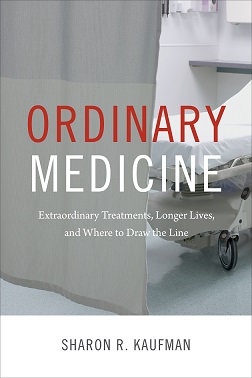I am delighted to be the recipient of the honorable mention, Diane Forsythe Prize for Ordinary Medicine: Extraordinary Treatments, Longer Lives and Where to Draw the Line (Duke University Press 2015). The book is an ethnography of the invisible social, economic, and bureaucratic forces that have made once extraordinary therapies seem ordinary and necessary.

Medicine’s ability to prolong wanted life through both low-tech and high-tech interventions is a positive development in many respects. Yet the socio-medical imperative to employ death-defying techniques now exists in an ever-aging society in which private industry churns out greater numbers of interventions than ever before; in which no age or cost limits exist for insurance reimbursement of those procedures; in which many older persons, their families and their health providers must consider whether additional treatment will bring with it pain and suffering; and in which saying ‘no’ to new technologies seems somehow suspect or ethically wrong. These features of American society and health care organization have spurred our lively national conversation about whether staving off death is always the best thing to do. And, those features have created the quandary, experienced by millions, of where to draw the line between ‘enough’ and ‘too much’ treatment.
As a medical anthropologist, I have spent more than 20 years watching this quandary play out in hospitals, clinics, bedsides and kitchen tables and asking why it cuts such a wide swath through the public conversation about control over the time for dying. In 2002 I began to observe older patients in specialty clinics, where they were often offered life-prolonging therapies. I listened to hundreds of patients, physicians and family members deliberate about what to do, heard them express their hopes, fears and reasoning. I have had a ringside seat on the evolution of their dilemmas about crossing the line of “too much” and their desire to do everything possible to prolong life. Many patients ask their doctors what they themselves would do in similar situations, and doctors, notably, do not answer definitively.
I started tracing the themes that I heard in the clinic conversations about evidence and expectations, norms and standards, risks, hope and ambivalence, the urge to try everything and the demand to stop. The talk mostly settled on scientific evidence, standards of care, risk reduction and necessary treatments, which led me to investigate how and why these have come to organize our “more is always better” approach to medicine. That quest, in turn, led me to think about the larger engines of the biomedical economy—the research and insurance industries (especially the clinical trials enterprise and Medicare)—and their impact on what we do when life is at stake.
Centered on the dilemmas 21st century American health care poses, Ordinary Medicine focuses on the intersection of biomedical science, the lure of new technologies and our aging society to reveal the hidden organization and ethics of health care delivery that determines so much about how we grow older, express love and care and approach the end of life. I follow the chain of health care drivers from research funding for treatments, to what is reimbursed by insurance companies, to what is considered standard and necessary and why, to what, ultimately, patients and doctors talk about and decide to do. The ethnography reveals how the organization of the system determines so much of what happens to everyone and why it is so difficult to see the line between ‘enough’ and ‘too much’ medical intervention. By providing a map to the socio-cultural sources of our health care dilemmas, Ordinary Medicine offers a way to re-think and renew the goals of medicine, so that it can serve as a social good in the twenty-first century.
The good news is that despite the increased influence of the drug and device companies in promoting the use of aggressive treatments in later life, and even though the technological imperative in medicine remains a powerful driver, the medical scene has changed in the past decade for the better and continues to do so. Palliative care has been accepted by greater numbers of doctors, patients, families and hospitals than in the past. It is taught in medical schools. The right-to-die consumer movement in health care has gained adherents and makes front-page news. Solutions to waste, overtreatment, futile intervention and patient and family suffering have been implemented in many medical centers and physician groups. Hospitals, patient advocacy groups, and regional health care systems are working in various ways to change the default away from more so that age, comfort, meaning and mortality are acknowledged. Yet there is still a long way to go because of the contradictory fact that we desire new, even experimental medical interventions without limit at the same time that we deplore the overuse of those tools and the suffering they sometimes cause. In that way the quandary of the line continues to have profound effects.
Sharon Kaufman is Chair of the Department of Anthropology, History and Social Medicine at the University of California, San Francisco. Her work explores topics at the intersection of medical knowledge and society’s expectations for health. She is also the author of …And a Time to Die: How American Hospitals Shape the End of Life.

1 Trackback